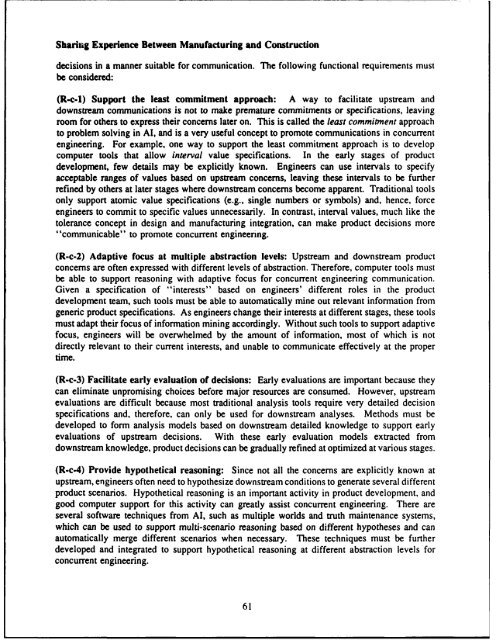Challenges and Opportunities for Innovation in the Public Works ...
Challenges and Opportunities for Innovation in the Public Works ...
Challenges and Opportunities for Innovation in the Public Works ...
Create successful ePaper yourself
Turn your PDF publications into a flip-book with our unique Google optimized e-Paper software.
Shar<strong>in</strong>g Experience Between Manufactur<strong>in</strong>g <strong>and</strong> Construction<br />
decisions <strong>in</strong> a manner suitable <strong>for</strong> communication. The follow<strong>in</strong>g functional requirements must<br />
be considered:<br />
(R-c-1) Support <strong>the</strong> least commitment approach: A way to facilitate upstream <strong>and</strong><br />
downstream communications is not to make premature commitments or specifications, leav<strong>in</strong>g<br />
room <strong>for</strong> o<strong>the</strong>rs to express <strong>the</strong>ir concerns later on. This is called <strong>the</strong> least commitment approach<br />
to problem solv<strong>in</strong>g <strong>in</strong> Al, <strong>and</strong> is a very useful concept to promote communications <strong>in</strong> concurrent<br />
eng<strong>in</strong>eer<strong>in</strong>g. For example, one way to support <strong>the</strong> least commitment approach is to develop<br />
computer tools that allow <strong>in</strong>terval value specifications. In <strong>the</strong> early stages of product<br />
development, few details may be explicitly known. Eng<strong>in</strong>eers can use <strong>in</strong>tervals to specify<br />
acceptable ranges of values based on upstream concerns, leav<strong>in</strong>g <strong>the</strong>se <strong>in</strong>tervals to be fur<strong>the</strong>r<br />
ref<strong>in</strong>ed by o<strong>the</strong>rs at later stages where downstream concerns become apparent. Traditional tools<br />
only support atomic value specifications (e.g., s<strong>in</strong>gle numbers or symbols) <strong>and</strong>, hence, <strong>for</strong>ce<br />
eng<strong>in</strong>eers to commit to specific values unnecessarily. In contrast, <strong>in</strong>terval values, much like <strong>the</strong><br />
tolerance concept <strong>in</strong> design <strong>and</strong> manufactur<strong>in</strong>g <strong>in</strong>tegration, can make product decisions more<br />
"communicable" to promote concurrent eng<strong>in</strong>eer<strong>in</strong>g.<br />
(R-c-2) Adaptive focus at multiple abstraction levels: Upstream <strong>and</strong> downstream product<br />
concerns are often expressed with different levels of abstraction. There<strong>for</strong>e, computer tools must<br />
be able to support reason<strong>in</strong>g with adaptive focus <strong>for</strong> concurrent eng<strong>in</strong>eer<strong>in</strong>g communication.<br />
Given a specification of "<strong>in</strong>terests" based on eng<strong>in</strong>eers' different roles <strong>in</strong> <strong>the</strong> product<br />
development team, such tools must be able to automatically m<strong>in</strong>e out relevant <strong>in</strong><strong>for</strong>mation from<br />
generic product specifications. As eng<strong>in</strong>eers change <strong>the</strong>ir <strong>in</strong>terests at different stages, <strong>the</strong>se tools<br />
must adapt <strong>the</strong>ir focus of <strong>in</strong><strong>for</strong>mation m<strong>in</strong><strong>in</strong>g accord<strong>in</strong>gly. Without such tools to support adaptive<br />
focus, eng<strong>in</strong>eers will be overwhelmed by <strong>the</strong> amount of <strong>in</strong><strong>for</strong>mation, most of which is not<br />
directly relevant to <strong>the</strong>ir current <strong>in</strong>terests, <strong>and</strong> unable to communicate effectively at <strong>the</strong> proper<br />
time.<br />
(R-c-3) Facilitate early evaluation of decisions: Early evaluations are important because <strong>the</strong>y<br />
can elim<strong>in</strong>ate unpromis<strong>in</strong>g choices be<strong>for</strong>e major resources are consumed. However, upstream<br />
evaluations are difficult because most traditional analysis tools require very detailed decision<br />
specifications <strong>and</strong>, <strong>the</strong>re<strong>for</strong>e, can only be used <strong>for</strong> downstream analyses. Methods must be<br />
developed to <strong>for</strong>m analysis models based on downstream detailed knowledge to support early<br />
evaluations of upstream decisions. With <strong>the</strong>se early evaluation models extracted from<br />
downstream knowledge, product decisions can be gradually ref<strong>in</strong>ed at optimized at various stages.<br />
(R-c-4) Provide hypo<strong>the</strong>tical reason<strong>in</strong>g: S<strong>in</strong>ce not all <strong>the</strong> concerns are explicitly known at<br />
upstream, eng<strong>in</strong>eers often need to hypo<strong>the</strong>size downstream conditions to generate several different<br />
product scenarios. Hypo<strong>the</strong>tical reason<strong>in</strong>g is an important activity <strong>in</strong> product development, <strong>and</strong><br />
good computer support <strong>for</strong> this activity can greatly assist concurrent eng<strong>in</strong>eer<strong>in</strong>g. There are<br />
several software techniques from AI, such as multiple worlds <strong>and</strong> truth ma<strong>in</strong>tenance systems,<br />
which can be used to support multi-scenario reason<strong>in</strong>g based on different hypo<strong>the</strong>ses <strong>and</strong> can<br />
automatically merge different scenarios when necessary. These techniques must be fur<strong>the</strong>r<br />
developed <strong>and</strong> <strong>in</strong>tegrated to support hypo<strong>the</strong>tical reason<strong>in</strong>g at different abstraction levels <strong>for</strong><br />
concurrent eng<strong>in</strong>eer<strong>in</strong>g.<br />
61







